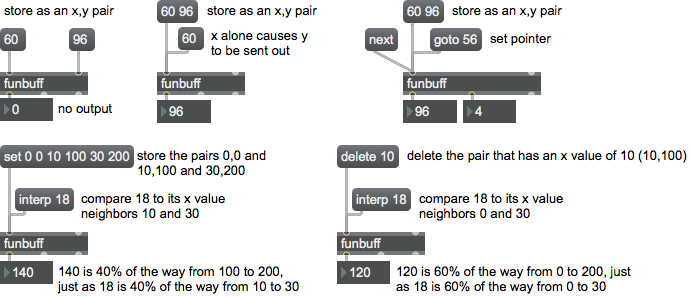funbuff
Description
Stores, manages, and recalls pairs of numbers.
Examples

Arguments
filename [symbol]
The argument specifies the name of a file to be read into funbuff when the patch is loaded. Changes to the contents of one funbuff will not affect the contents of another funbuff object with the same name.
A file for funbuff can also be created using a text editor window, beginning the text with the word , followed by a list of space-separated numbers which specify alternating x and y values. A funbuff that has been saved as a file can be viewed and edited as text by choosing Open as Text... from the File menu. Numbers in the form of text can be pasted in from other sources such as the editing window of a capture object, or even from another program such as a word processor.
Attributes
Common Box Attributes
annotation [symbol]
Sets the text that will be displayed in the Clue window when the user moves the mouse over the object.
background [int] (default: 0)
Adds or removes the object from the patcher's background layer. adds the object to the background layer, removes it. Objects in the background layer are shown behind all objects in the default foreground layer.
color [4 floats]
Sets the color for the object box outline.
fontface [int]
Sets the type style used by the object. The options are:
plain
bold
italic
bold italic
Possible values:
0 = 'regular'
1 = 'bold'
2 = 'italic'
3 = 'bold italic'
fontname [symbol]
Sets the object's font.
fontsize [float]
Sets the object's font size (in points).
Possible values:
'8'
'9'
'10'
'11'
'12'
'13'
'14'
'16'
'18'
'20'
'24'
'30'
'36'
'48'
'64'
'72'
hidden [int] (default: 0)
Toggles whether an object is hidden when the patcher is locked.
hint [symbol]
Sets the text that will be displayed in as a pop-up hint when the user moves the mouse over the object in a locked patcher.
ignoreclick [int] (default: 0)
Toggles whether an object ignores mouse clicks in a locked patcher.
jspainterfile [symbol]
JS Painter File
patching_rect [4 floats] (default: 0. 0. 100. 0.)
Sets the position and size of the object in the patcher window.
position [2 floats]
Sets the object's x and y position in both patching and presentation modes (if the object belongs to its patcher's presentation), leaving its size unchanged.
presentation [int] (default: 0)
Sets whether an object belongs to the patcher's presentation.
presentation_rect [4 floats] (default: 0. 0. 0. 0.)
Sets the x and y position and width and height of the object in the patcher's presentation, leaving its patching position unchanged.
rect [4 floats]
Sets the x and y position and width and height of the object in both patching and presentation modes (if the object belongs to its patcher's presentation).
size [2 floats]
Sets the object's width and height in both patching and presentation modes (if the object belongs to its patcher's presentation), leaving its position unchanged.
textcolor [4 floats]
Sets the color for the object's text in RGBA format.
textjustification [int]
Sets the justification for the object's text.
Possible values:
0 = 'left'
1 = 'center'
2 = 'right'
varname [symbol]
Sets the patcher's scripting name, which can be used to address the object by name in pattr, scripting messages to thispatcher, and the js object.
Messages
bang
int
Arguments
If there is no stored x value which matches the number received, funbuff uses the closest x value which is less than the number received, and sends out the corresponding y value.
(inlet1)
Arguments
float
Arguments
clear
copy
cut
delete
Arguments
y-value [int]
dump
embed
Arguments
find
Arguments
goto
Arguments
interp
Arguments
interptab
Arguments
tablename [symbol]
max
min
next
paste
read
Arguments
select
Arguments
set
Arguments
undo
Output
bang
Out right outlet: When the pointer reaches the end of a funbuff, no numbers are sent out in response to a message, but a is sent out to notify that the end has been reached.
int
Out left outlet: When an x value is received in the left inlet, the corresponding y value is sent out. (Or, if there is no such x value yet stored in funbuff, the y value corresponding to the next lesser x value is sent out.) When the word is received in the left inlet, funbuff sends out the y value that corresponds to the x value pointed to by its pointer (or, if there is no such x value, the y value of the next greater x value).
Out middle outlet: When the word is received in its left inlet, funbuff sends out the difference between the x value pointed to by its pointer, and the x value previously pointed to, then resets the pointer to the next x value.
See Also
| Name | Description |
|---|---|
| bline | Generate ramps using bang |
| coll | Store and edit a collection of data |
| funbuff | Store pairs of numbers |
| itable | Data table editor |
| line | Generate timed ramp |
| table | Store and edit an array of numbers |